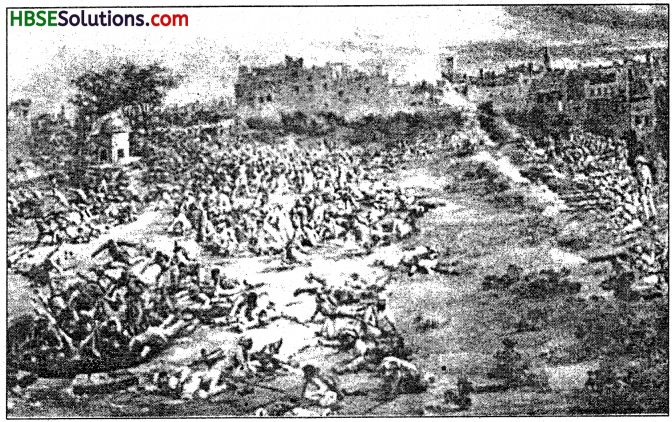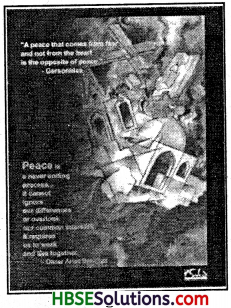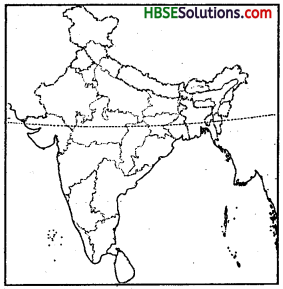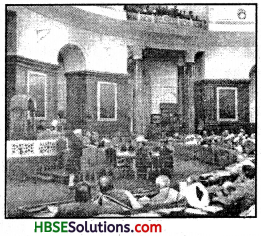HBSE 8th Class Social Science Solutions Geography Chapter 4 Agriculture
Haryana State Board HBSE 8th Class Social Science Solutions Geography Chapter 4 Agriculture Textbook Exercise Questions and Answers.
Haryana Board 8th Class Social Science Solutions Geography Chapter 4 Agriculture
HBSE 8th Class Geography Agriculture Textbook Questions and Answers
EXERCISES
Question 1.
Answer the following questions:
(i) What is agriculture?
Answer:
The science and art of cultivation of the soil, raising crops, and rearing livestock are called agriculture. It is a primary activity and one of the oldest occupations known to humans.
(ii) Name the factors influencing agriculture.
Answer:
The factors influencing agriculture are:
(a) Climate
(b) Soil
(c) Relief
(d) Other factors like availability of irrigation facilities, size of landholdings, transport facilities, nearness of market etc.
(iii) What is shifting cultivation? What are its disadvantages?
Answer:
Shifting cultivation is the process of agriculture where a small area of a forest is cleared by cutting down all the trees and the area is burned. The ashes are mixed with soil to make it more fertile and the land is used for growing crops. After a couple of years, when the land becomes less fertile, it is abandoned.
The disadvantages of shifting cultivation are:
(а) It has led to deforestation and loss of natural vegetation.
(b) It leads to soil erosion and soil loss.
(iv) What is plantation agriculture?
Answer:
Plantation agriculture is a type of commercial farming practised on farms called estates to grown a single crop like tea, coffee, sugarcane, rubber, banana etc. The plantations are managed like industrial units.
(v) Name the fibre crops and name the climatic conditions required for their growth.
Answer:
The fibre crops are : Cotton, Jute
Climatic conditions for their growth are:
Cotton :
(а) High temperature of about 27°C during the growing period.
(b) Rainfall of about 60 cm to 100 cm in frequent showers.
(c) Fertile, well drained soil.
(d) Dry, clear and sunny weather during the ripening of the cotton bolls.
Jute:
(а) Warm and wet climate.
(b) Alluvial soil, well-drained.
(c) Heavy rainfall.
Question 2.
Tick (✓) the correct answer:
(i) Horticulture means:
(a) growing of fruits and vegetables
(b) primitive farming
(c) growing of wheat
Answer:
(a) growing of fruits and vegetables.
(ii) Golden fibre refers to :
(a) tea
(b) cotton
(c) jute
(c) jute.
Answer:
(c) jute.
(iii) Leading producers of coffee _________.
(a) Brazil
(b) India
(c) Russia
Answer:
(a) Brazil.
![]()
Question 3.
Give reasons :
(i) In India agriculture is a primary activity.
Answer:
About 75 percent of India’s population lives in villages and depend directly or indirectly on agriculture. It provides food for human beings and raw materials for agro-based industries.
(ii) Different crops are grown in different regions.
Answer:
Different crops are grown in different regions because the different climatic conditions and favourable soil are required for different crops which is found in different regions.
Question 4.
Distinguish between the followings:
(i) Primary activities and tertiary activities.
(ii) Subsistence farming and intensive farming.
Answer:
(i)
| Primary Activities | Tertiary Activities |
| Primary activities include all those connected with extraction and production of natural resources. | Tertiary activities are the activities which provide support to primary and secondary sectors through services. |
| For example: Agriculture, fishing, mining etc. | For example: Transport, trade, banking, insurance advertising. |
(ii)
| Subsistence Farming | Intensive Farming |
| (a) This is mainly practised to meet the needs of the farmer’s family. | (a) The farmer tries to get the maximum possible output from a small plot of land. It is practised in densely populated countries in the monsoon region. |
| (b) The farmer uses primitive methods to produce a variety of crops. | (b) The farmer uses simple tools and abundant human labour. |
| (c) All types of manure and a little of chemical fertilizers are used. | (c) This is mostly done on fertile soil. |
Question 5.
Activity :
(i) Collect seeds of wheat, rice, jowar, bajra, ragi, maize, oilseeds and pulses available in the market. Bring them to the class and find out in which type of soil they grow.
Answer:
- Wheat: It grows good in well-drained loamy soil. Black soil provides excellent quality grain.
- Rice : It grows well in alluvial clayey soil which can retain water.
- Jowar, Bajra, Ragi : These can be grown in less fertile and sandy soil.
- Maize : It requires well-drained, deep and fertile soil.
- Oilseeds: Groundnuts are grown in alluvial soil and in black soil. Mustard requires alluvial soil.
- Pulses : They are grown in less fertile alluvial soil and red soil.
(ii) Find out the difference between the life style of farmers in the USA and India on the basis of pictures collected from magazines, books and newspapers and the internet.
Answer:
The following points will clear the difference between the life style of farmers in USA and India.
Life Style of Farmers In USA:
- Farmers have large size of farms ranging between 100-300 hectares.
- They use high dose of fertilizers.
- They use modern techniques and machines like harvesters in agriculture.
- They generally live in farm houses.
- They use high quality seeds and take adequate measures to control pests and improve soil fertility.
- They are generally educated. They work like businessmen and maintain proper accounts of expenditure and income.
- They sell their produce in big markets and export to other countries also.
Life Style of Farmers In India:
- The farmers generally do not have farms more than 1.5 hectares in area.
- They generally hire big machines for farming or work with small machines.
- They are not aware of the properties of soil and lack soil testing facilities.
- The farmers lack storage facilities and sell produce in the nearby markets (mandis).
- They are not educated and cannot keep account of farm activities.
- They live in kuchcha houses in villages.
- All the members of family are engaged in agricultural activities.
![]()
Question 6.
FOR FUN
Solve the crossword puzzle with the help of given clues:
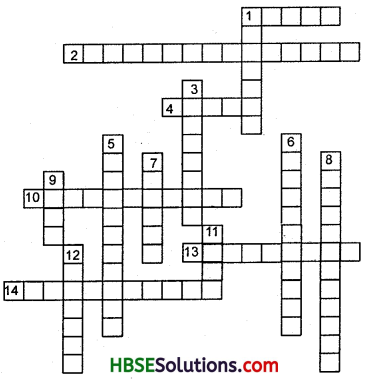
Across :
1. Crop that needs well drained fertile soils, moderate temperatures and lots of sunshine (5).
2. Increasing production through use of HYV seeds, chemical fertilisers and pesticides (5,10).
4. USA, Canada, Russia, Australia are major producers of this crops (5)
10. Type of farming to meet family needs (11)
13. Rearing of animals for sale (9)
14. Growing grapes for wines (11)
Down:
1. Coarse grains are also called (7)
3. Cultivation involving slash and burn (8)
5. Growing of crops, fruits and vegetables (11)
6. Tea, coffee, sugarcane and rubber are grown in (11)
7. Requires 210 frost-free days for growth (6).
8. Growing of flowers (12)
9. Also called ‘Golden Fibre’ (4)
11. Also known as paddy (4)
12. Activity concerned with extraction of natural resources (7)
Answer:
Across :
1. MAIZE
2. GREEN REVOLUTION
4. WHEAT
10. SUBSISTENCE
13. LIVESTOCK
14. VITICULTURE
Down :
1. MILLETS
3. SHIFTING
5. AGRICULTURE
6. PLANTATIONS
7. COTTON
8. HORTICULTURE
9. JUTE
11. RICE
12. PRIMARY
HBSE 8th Class Geography Agriculture Important Questions and Answers
Very Short Answer Type Questions
Question 1.
What are the two essentials for agricultural activity?
Answer:
Favourable topography of soil, climate.
Question 2.
Name three secondary activities.
Answer:
Manufacturing of steel, baking of bread, weaving of cloth.
Question 3.
What is arable land?
Answer:
The land on which the crops are grown is known as arable land.
Question 4.
What is organic farming?
Answer:
In this type of farming, organic manure and natural pesticides are used instead of chemicals.
![]()
Question 5.
What types of farming are included in commercial farming?
Answer:
Commercial farming includes commercial grain farming, mixed farming and plantation agriculture.
Question 6.
What is done in mixed farming?
Answer:
In mixed farming the land is used for growing food and fodder crops and rearing livestock.
Short Answer Type Questions
Question 1.
What climatic conditions are required for the cultivation of cotton?
Answer:
- high temperature.
- light rainfall
- two hundred and ten frost-free days.
- bright sunshine.
Question 2.
What are different types of fibre crops?
Answer:
Fibre Crops : Fibre is a material produced from vegetables, animals, minerals and chemicals. Vegetables fibres are procured from seeds, stems, leaves and fruit cases. Animal fibres are produced from insects like silkworms, from animals like sheep, goats, yaks, llamas, rabbits, reindeers and camels. Minerals fibres, like glass, are made from silica sand. Synthetic fibres are obtained from chemical treatment of natural cellulose, made of wood pulp. Two important sources of vegetable fibre are cotton and jute.
Long Answer Type Questions
Question 1.
Describe the regions where commercial grain farming is practised.
Answer:
(a) Commercial grain farming is practised in the temperate grasslands of North America, Europe and Asia.
(b) These regions are sparsely populated with large farms sprading over hundreds of hectares.
(c) Due to severe winters only a single crop can be grown.
Question 2.
Write a short note on millets.
Answer:
- Millets are also known as coarse grains and can be grown on less fertile and sandy soils.
- It is a hardy crop that needs low rainfall and high to moderate temperature and adequate rainfall.
- Millets are grown in India, Nigeria, China and Niger.
Question 3.
Write the geographical conditions required for the cultivation of tea.
Answer:
- Tea requires cool climate and well distributed high rainfall throughout the year for the growth of its tender leaves.
- It needs well-drained loamy soils and gentle slopes.
- Large number of labour is required to pick the leaves.
![]()
Agriculture Class 8 HBSE Notes
- Agriculture : The science and art of cultivation on the soil, raising crops and rearing livestock.
- Sericulture : Commerical rearing of silk worms.
- Pisciculture : Breeding of fish in specially constructed tanks and ponds.
- Viticulture : Cultivation of grapes.
- Horticulture : Growing vegetables, flowers and fruits for commerical use.
- Subsistence Farming: This is the type of farming carried out by a farmer to satisfy the needs of his family alone.
- Nomadic Farming: Nomadic farming refers to the practice of farming in which herdsmen move from one place to another, with their families and their livestocks.
- Commercial Farming: The crops are grown and animals are reared to sell in the market.
- Mixed Farming: In mixed farming, livestocks are reared along with the farming of food and fodder crops.
- Agricultural Development: Agricultural development refers to the increase in farm production in order to meet the demands of a growing population.
